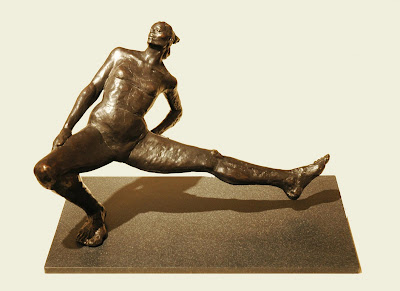 Step into WSG gallery's entry space and you'll be welcomed by a group of bronze sculptures first. You may stop, wait for them to draw a breath, lift an arm, flex on the ball of a foot, make their next move....
Step into WSG gallery's entry space and you'll be welcomed by a group of bronze sculptures first. You may stop, wait for them to draw a breath, lift an arm, flex on the ball of a foot, make their next move....Norma has studied the figure as her primary inspiration, capturing each dancer at the point just before the next gesture - at a point that leaves the viewer anticipating what comes next.
On the walls, you'll see Norma's spectacular drawings. You can see the artist's work process in these pieces, as she sees the figure, records in on paper, imagines the figure's next movement, records it on top of the first drawing, and so on. The drawings have such a poetic nature - meditative, really. The black and gray lines are so elegant against the white paper!

A slight departure from Norma's bronze work and framed drawings are her wall-hung box pieces. I say slight, because her drawings and sculpture provide a stepping-off point for these little pieces. Norma starts with an antique sewing drawer and uses drawings of her dancers, beautiful papers, clay objects and parts from sculptures to create these assemblage pieces.
 "Dance With Me", above, is one such piece. The box pieces provide the artist with more immediate satisfaction than the bronze pieces - a nice break from the labor-intensive process of sculpting, moulding, casting in wax, investing in ceramic shell, pouring bronze, chasing, patinating and mounting on a base (WHEW!). Working in several different veins, an artist can feed her soul, invigorate her thought process and, ultimately, discover things that translate among the media she explores.
"Dance With Me", above, is one such piece. The box pieces provide the artist with more immediate satisfaction than the bronze pieces - a nice break from the labor-intensive process of sculpting, moulding, casting in wax, investing in ceramic shell, pouring bronze, chasing, patinating and mounting on a base (WHEW!). Working in several different veins, an artist can feed her soul, invigorate her thought process and, ultimately, discover things that translate among the media she explores.Norma Penchansky-Glasser's work will be featured from May 18 through June 27, 2010. Gallery hours are Tu, Wed noon to 6, Th - Sat, noon - 10 pm and Sunday noon - 5pm. WSG gallery is located at 306 S. Main St., Ann Arbor.


